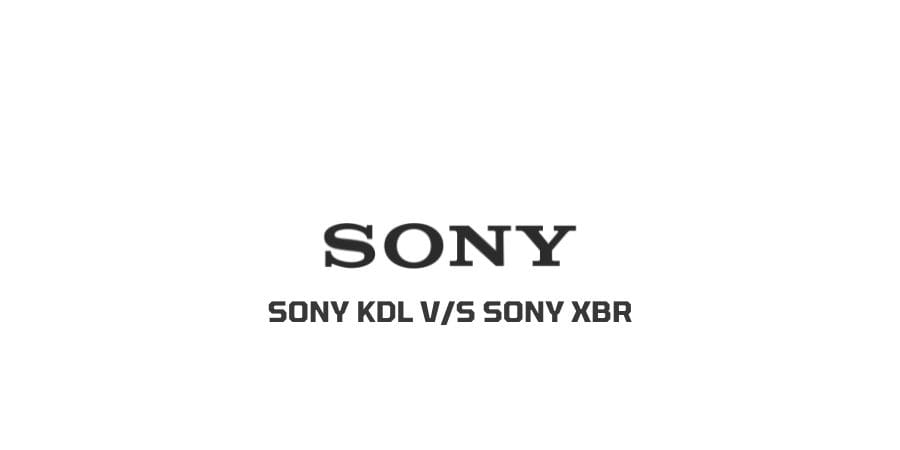
Sony is a pioneer in the technology market. They sell many devices and are good with all of them.
Sony KDL and Sony XBR are the different television models that the technology giant sells. Both the devices are great but are very different from each other when we discuss their features.
This article aims to compare both models so that you can make a better decision about what to purchase depending on your requirements.
We will discuss the strengths and the shortcomings of both the device models and help you understand what aligns better with the requirements that you have.
So, let’s dive into the features of both Sony KDL and Sony XBR TV models and compare Sony KDL v/s Sony XBR.
Let’s get started.
Sony KDL Features
Let us take a look at the specific features that Sony KDL TV offers. This will help us understand what makes this machine unique and worthy of a purchase.
- The screen size is 81 cm. Also, the viewing ratio is set at a standard 16:9.
- The HDMI video format is supported with a resolution of up to 1080 pixels. The resolution is also set at full HD.
- There is a distinct component of viewing angle that supports up to 178 degrees both up/down and right/left. This helps when you are not viewing the TV directly from the front. Even if you look at the TV from a different angle, it will not give you a glare and the visibility will not be lost.
- It offers intelligent noise reduction in MPEG format. This provides you with the best audio without any distractions.
- The TV offers various viewing modes that can be used according to the content you are watching. The different modes include the cinema mode, gaming mode, photo, video, and many more.
- There is an intelligent image enhancer that helps provide the users with the best quality image there is.
- The audio has a surround mode with simulated stereo. You can choose from the audio options pertaining to dynamic, standard, or clear voice.
- The audio is powered by Dolby sound who is a pioneer in the market when it comes to audio technology.
- It has many terminals that can be used to connect to the internet, HDMI cable, headphones, gaming consoles, and many more things that you may need.
- There are many advanced features like connecting to the Bravia ecosystem, a sleep timer, clock, photo map, Teletext, etc.
- The TV also has a parental control setting where you can set up permissions for the other users in the house that are underage. This can help you restrict content according to age.
- In terms of connectivity, the TV is really advanced and can be connected to the Wifi. is also ready for using Skype. Media remote and Wifi direct connectivity is also possible.
- The TV is also equipped with features like backlight control and power-saving modes. This makes the TV more eco-friendly.
- Comes with batteries and remote control.
- The weight of the TV is approximately 10.6 kgs which is not a lot. The power consumption is 70 W.
- The TV is also 3D compatible and the best thing to consider here is that you do not need any special glasses to get the effect.
These were the special features that you can enjoy when you buy a Sony KDL TV. Now, let us discuss the other model which is Sony XBR.
Sony XBR Features
- Uses an LED Backlight display. This provides you with a much better resolution when you think about other devices in the same range that do not offer this feature.
- The video quality is HDR 10. This is a great comparison to the SDR that is offered by the other models.
- The refresh rate with this TV is really high as compared to the KDL device. The KDL offers only 200Hz while this version uses 960 Hz. A higher refresh rate is extremely helpful to reduce the noise on the screen and allows for seamless video transition.
- Is equipped with an ambient light sensor.
- The device can also project in 3D but you need to have glasses to watch 3D video on this model, unlike the KDL device where the glasses are not needed.
- The TV supports a Wifi connection and has 3 USB ports. The KDL device has only 2 USB ports.
- Supports HDMI 2.0 which is the newer version of HDMI. The KDL device offers you HDMI 1.0
- The audio is powered by Dolby audio just like the KDL TV. as we have discussed earlier, this is a pioneer in the field of audio connections and devices.
- It has advanced features like a Sleep timer, the surround sound feature, and child lock.
- It also offers a search browser.
- The device also supports Skype and can be used for video calling which was also true for the KDL device that we discussed above.
Which device is better? Sony KDL vs Sony XBR
The article does not aim to tell you that one device model is better than the other. The aim of the article was to let you know the features that both the models offer.
Based on your specific requirements, you can pick the device that comes closest to what you need. Both the devices are designed exceptionally well and are equipped with the best technology in the market.
Also, when the devices are backed by the technology giant Sony, you can always make sure that you are taking a quality product home no matter what you are picking.
Conclusion
We have discussed the exclusive features of both Sony KDL and Sony XBR TVs. for more information, you can visit the Sony center in person or visit the official website of Sony devices to get an exclusive list of features.
You can also read the user reviews which is suggested before you buy any device because it helps you know what other users are experiencing after their purchase. We hope that this was helpful and you are now at a better place to make a decision.
Like This Post? Checkout More
